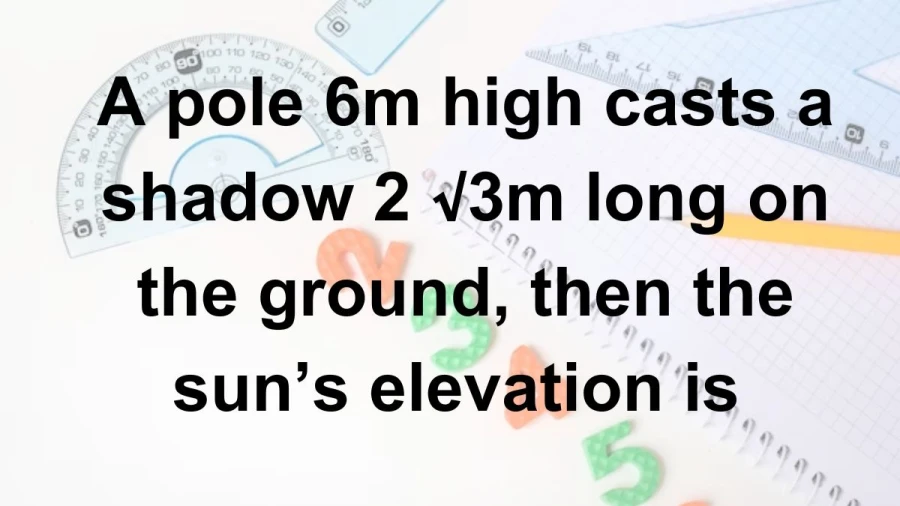If you happen to be viewing the article A pole 6m high casts a shadow 2 √3m long on the ground, then the sun’s elevation is ? on the website Math Hello Kitty, there are a couple of convenient ways for you to navigate through the content. You have the option to simply scroll down and leisurely read each section at your own pace. Alternatively, if you’re in a rush or looking for specific information, you can swiftly click on the table of contents provided. This will instantly direct you to the exact section that contains the information you need most urgently.
A pole 6m high casts a shadow 2 √3m long on the ground, then the sun’s elevation is
The sun’s elevation angle is approximately 60 degrees.
Given: Height of the pole, h = 6 metersLength of the shadow, s = 2√3 meters
We use the tangent function to find the sun’s elevation angle (E):
tan(E) = h / s
Substituting the given values: tan(E) = 6 / 2√3
Rationalizing the denominator: tan(E) = 6 / 2√3 × √3 / √3 tan(E) = 6√3 / 6
Simplify: tan(E) = √3
Taking the arctan of both sides to find E: E = arctan(√3)
Using a calculator or trigonometric table: E ≈ 60 degrees
So, the sun’s elevation angle is approximately 60 degrees.
Calculating Heights and Distances
Calculating heights and distances typically refers to the mathematical process of determining the height of an object or the distance between two objects using trigonometry, specifically right-angle trigonometry (sine, cosine, tangent functions), along with some basic geometric principles.
Article continues below advertisement
Article continues below advertisement
Here’s a basic explanation of how it works:
-
Understanding Trigonometry: Trigonometry deals with the relationships between the angles and sides of triangles. In particular, when dealing with right-angled triangles, we use trigonometric functions like sine, cosine, and tangent.
-
Using Similar Triangles: One key principle used in many height and distance problems is the concept of similar triangles. Similar triangles are triangles that have the same shape but possibly different sizes. In other words, their corresponding angles are equal, and their corresponding sides are in proportion.
-
The Basics: Let’s say you’re standing at a known distance from an object, and you want to find the height of that object. You measure the angle of elevation from your eye level to the top of the object.
-
Using Trigonometry: With this angle and the known distance from you to the object, you can set up a trigonometric equation involving the tangent function. Tangent of an angle in a right triangle is the ratio of the length of the side opposite the angle to the length of the adjacent side.
So, if ‘θ’ is the angle of elevation, ‘d’ is the distance from you to the object, and ‘h’ is the height of the object, then you can use the formula:
tan(θ) = h/d
Solving this equation for ‘h’ gives you the height of the object.
-
Other Scenarios: There are various scenarios where you might need to calculate distances or heights using trigonometry. For example, you might need to find the distance between two objects by measuring angles of elevation or depression from each object to a third point with a known distance from one of the objects.
-
Accuracy and Assumptions: It’s important to note that these calculations are based on certain assumptions, such as the ground being flat, the absence of obstacles, and accurate measurements of angles and distances. In real-world scenarios, these assumptions may not hold, so the calculated values might have some margin of error.
-
Practice: The best way to understand and become proficient in calculating heights and distances using trigonometry is through practice. Working through different examples and scenarios will help reinforce the concepts and techniques involved.
In summary, calculating heights and distances involves using trigonometric principles and the properties of similar triangles to determine unknown measurements based on known angles and distances in right-angled triangles.
Thank you so much for taking the time to read the article titled A pole 6m high casts a shadow 2 √3m long on the ground, then the sun’s elevation is written by Math Hello Kitty. Your support means a lot to us! We are glad that you found this article useful. If you have any feedback or thoughts, we would love to hear from you. Don’t forget to leave a comment and review on our website to help introduce it to others. Once again, we sincerely appreciate your support and thank you for being a valued reader!
Source: Math Hello Kitty
Categories: Math

